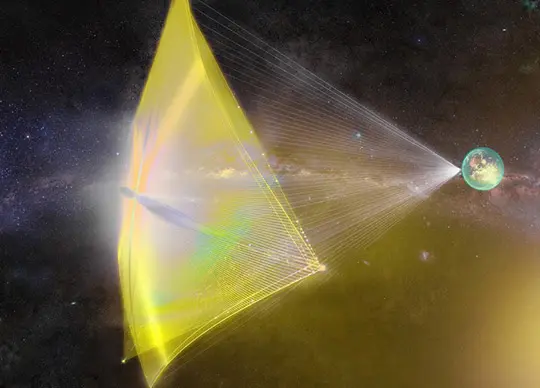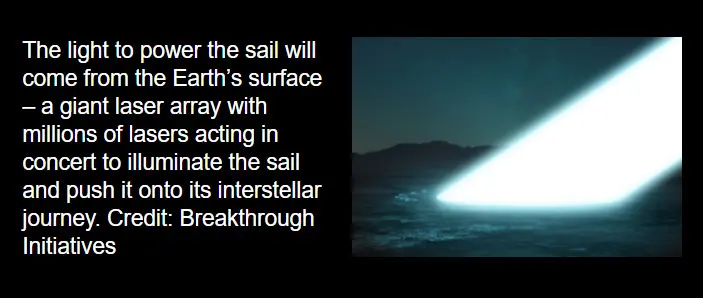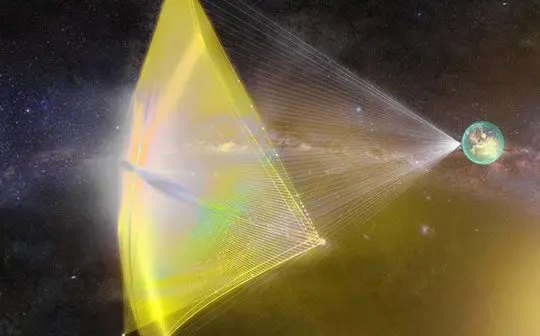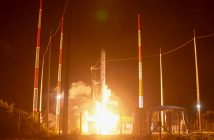
Scientists from The Australian National University (ANU) have designed a new type of space-craft propulsion system as part of an ambitious international project that aims to explore the worlds surrounding our second nearest star, Alpha Centauri.
The Breakthrough Starshot project calls for the design of an ultra-lightweight spacecraft, which acts as a light-sail, to travel with unprecedented speed over tens of trillions of kilometres to the star about four lightyears away, reaching the destination within 20 years.
The sheer scale and size of the interstellar distances between solar systems is difficult for most people to comprehend. Travel from Earth to Alpha Centauri using the today’s conventional spacecraft would take more than 100 lifetimes.
“To cover the vast distances between Alpha Centauri and our own solar system, we must think outside the box and forge a new way for interstellar space travel.”
In a recent paper published in the Journal of the Optical Society of America B, the ANU team, with funding support from Breakthrough Initiatives, outlines their design concept for the laser propulsion system to be used to launch the probes from Earth.
Lead author Dr Chathura Bandutunga said the light to power the sail will come from the Earth’s surface – a giant laser array with millions of lasers acting in concert to illuminate the sail and push it onto its interstellar journey.
“To cover the vast distances between Alpha Centauri and our own solar system, we must think outside the box and forge a new way for interstellar space travel,” Dr Bandutunga, from the Applied Metrology Laboratories at the ANU Centre for Gravitational Astrophysics, said.
“Once on its way, the sail will fly through the vacuum of space for 20 years before reaching its destination. During its flyby of Alpha Centauri, it will record images and scientific measurements which it will broadcast back to Earth.”
The ANU team has expertise in different areas of optics spanning astronomy, gravitational wave instrumentation, fiber-optic sensors and optical phased arrays.

The founding scientist who pioneered the ANU node of this project, Dr Robert Ward, said an important part of this grand vision is the development of the laser array – in particular, designing a system to have all the lasers act as one.
“The Breakthrough Starshot program estimates the total required optical power to be about 100 GW – about 100 times the capacity of the world’s largest battery today,” Dr Ward, from the ANU Research School of Physics, said.
“To achieve this, we estimate the number of lasers required to be approximately 100 million.
Researcher and fellow author, Dr Paul Sibley, said one of the main challenges we tackled is how to make measurements of each laser’s drift.
“We use a random digital signal to scramble the measurements from each laser and unscramble each one separately in digital signal processing,” he said.
“This allows us to pick out only the measurements we need from a vast jumble of information. We can then break the problem into small arrays and link them together in sections.”
To orchestrate the show, the ANU design calls for a Beacon satellite – a guide laser placed in Earth orbit which acts as the conductor, bringing the entire laser array together.
Professor Michael Ireland from the ANU Research School of Astronomy and Astrophysics said the design of the laser “engine” requires compensation for the atmosphere.
“Unless corrected, the atmosphere distorts the outgoing laser beam, causing it to divert from its intended destination,” he said.
“Our proposal uses a laser guide star. This is a small satellite with a laser which illuminates the array from Earth orbit. As the laser guide star passes through the atmosphere on the way back to Earth, it measures the changes due to the atmosphere.
“We have developed the algorithm which allows us to use this information to pre-correct the outgoing light from the array.”
Dr Bandutunga said just like the eventual light-sail, this research is at the beginning of a long journey.
“While we are confident with our design, the proof is in the pudding,” he said.
“The next step is to start testing some of the basic building blocks in a controlled laboratory setting. This includes the concepts for combining small arrays to make larger arrays and the atmospheric correction algorithms.
“The work done at ANU was to see if this idea would conceivably work. The goal was to find out-of-the-box solutions, to simulate them and determine if they were physically possible.
“While this proposal was put forward by the ANU team, there is more work happening internationally to come up with unique and clever solutions to other parts of the problem.
“It’ll be exciting to bring these solutions together to bring the project to life.





